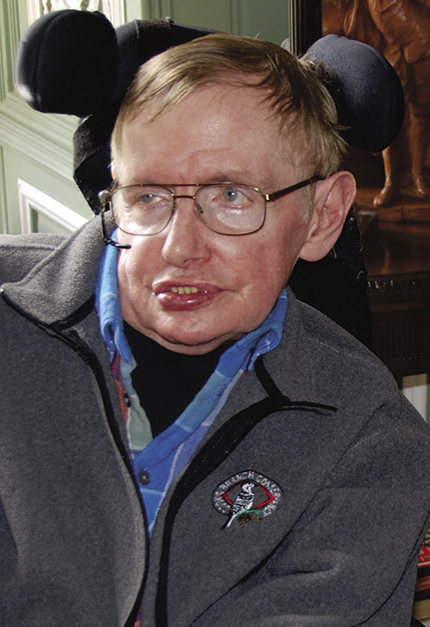Stephen William Hawking
DOI: 10.1063/PT.3.4003
Stephen William Hawking, arguably the most famous scientist of the late 20th and early 21st centuries, died peacefully at home in Cambridge, UK, on 14 March 2018.

Stephen William Hawking

Stephen made brilliant advances in classical general relativity and quantum gravity in the 55 years he survived, and thrived, after developing amyotrophic lateral sclerosis (ALS). He inspired dozens of students and postdocs who have worked on his ideas throughout their academic careers. Stephen also contributed enormously to the popularization of science, particularly with his best-selling 1988 book A Brief History of Time.
Born in Oxford, UK, on 8 January 1942, Stephen received his BA from University College Oxford in 1962 and entered Trinity Hall, Cambridge, as a doctoral student under Dennis Sciama. He began experiencing clumsiness and falls at Oxford, and tests in 1963 revealed an incurable disease, eventually diagnosed as ALS. Following a severe depression, Stephen realized he could still pursue his PhD.
In 1962 Stephen fell in love with Jane Wilde, and they were wed in 1965. Jane’s love and support during the extreme difficulties caused by ALS provided him with strong motivation to persevere. He developed a heroic single-mindedness and would not let ALS interfere with his passion for physics. For example, Stephen traveled worldwide to conferences, often against doctors’ advice. He even went to Antarctica and the Great Wall of China and flew on a zero-gravity flight. Stephen’s enormous courage was an inspiration to millions.
Excited by Roger Penrose’s proof of singularities inside generic black holes, Stephen adopted similar methods for his 1965 PhD thesis, “Properties of expanding universes.” He concluded that “provided certain physically reasonable conditions hold, any [cosmological] model must have a singularity” in classical general relativity. Stephen then turned his attention to black holes and in 1971 proved that their total surface area cannot decrease.
In 1973 Stephen and George Ellis published The Large Scale Structure of Space-Time. It became the authoritative reference on the astounding black hole and cosmology results that Stephen and others had proved in the decade before.
Stephen next considered how quantum theory could modify the results he and others had obtained from classical general relativity. He heard about my realization that rotating black holes would spontaneously emit radiation, also independently predicted by Yakov Zel’dovich and Alexei Starobinsky. Stephen liked their idea on physical grounds but not their mathematical calculations. However, as he wrote in A Brief History of Time, “when I did the calculation, I found, to my surprise and annoyance, that even non-rotating black holes should apparently create and emit particles at a steady rate.”
Stephen found that the radiation, now called Hawking radiation, was thermal and hence fitted with Jacob Bekenstein’s qualitative ideas about black hole entropy. Stephen showed that the entropy of a black hole is simply one-quarter of its area in Planck units. That discovery became the foundation for an enormous amount of research on the relationship between gravity, quantum theory, and thermodynamics. It also fostered a great mystery—what happens to the information of something that collapses into a black hole—which Stephen was still pursuing in five of his last six academic papers, such as his work on “soft hair” with Malcolm Perry and Andrew Strominger.
Stephen joined with James Hartle to make the bold proposal of the no-boundary wavefunction (NBWF) of the universe, introducing boundary conditions for determining the universe’s quantum state. Combined with Stephen’s contributions to the prediction of density fluctuations from inflationary cosmology, his work with Jonathan Halliwell suggests that the Hartle–Hawking NBWF may explain the structure we see in our universe, including galaxies, stars, planets, and even us (though Leonard Susskind and I have raised challenges). Stephen regarded the NBWF, the subject of his last paper with Thomas Hertog, as his greatest work.
I had the privilege of living with Stephen, Jane, and their children when I was his postdoc in 1976–79, and I helped provide him physical assistance. They warmly welcomed me as part of the family. For my first Christmas in England, when I was unable to join my parents back in the US, they invited me to join them at their parents’ homes. Walking to work with Stephen gave me an opportunity to think about physics questions he raised.
Stephen had a great, often self-deprecating, sense of humor. When the conclusions of a paper we cowrote disagreed with those of a previous paper he had coauthored, he commented, “This is one way to increase one’s publication list: First write one paper, and then write another showing that the first one was wrong.”
I last saw Stephen in 2016, when my family and I were visiting Cambridge, and he invited us to dinner. We had a wonderful time that we shall always treasure.
Stephen Hawking was not only an outstanding scientist and communicator but also an excellent mentor and close friend. His brilliance, humor, and friendship are greatly missed.
More about the Authors
Don N. Page. University of Alberta, Edmonton, Alberta, Canada.
